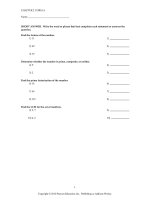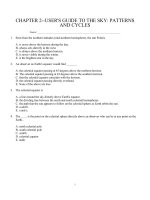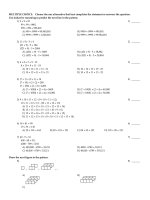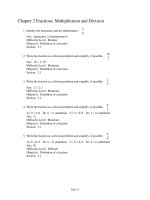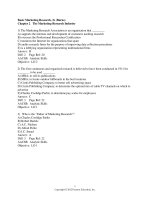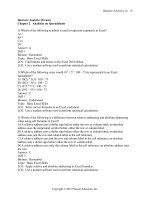Business statistics communicating with numbers 2nd edition jaggia test bank
Bạn đang xem bản rút gọn của tài liệu. Xem và tải ngay bản đầy đủ của tài liệu tại đây (986.61 KB, 203 trang )
Chapter 02
1. A frequency distribution for qualitative data groups these data into classes called intervals and
records the total number of observations in each class.
True
False
2. The relative frequency of a category is calculated by dividing the category's frequency by the total
number of observations.
True
False
3. The percent frequency of a category equals the frequency of the category multiplied by 100%.
True
False
4. A pie chart is a segmented circle that portrays the categories and relative sizes of some
quantitative variable.
True
False
5. A bar chart depicts the frequency or relative frequency of each category of qualitative data as a
bar rising vertically from the horizontal axis. It is also acceptable for the bar to extend horizontally
from the vertical axis.
True
False
6. A bar chart may be displayed horizontally.
True
False
7. To approximate the width of a class in the creation of a bar chart, we may use this formula:
True
False
8. For quantitative data, a relative frequency distribution identifies the proportion of observations that
fall into each class.
True
False
9. For quantitative data, a cumulative relative frequency distribution records the proportion (fraction)
of values that fall below the upper limit of each class.
True
False
10. A histogram is a series of rectangles where the width and height of each rectangle represent the
frequency (or relative frequency) and the width of the class, respectively.
True
False
11. A polygon connects a series of neighboring points where each point represents the midpoint of a
particular class and its associated frequency or relative frequency.
True
False
12. An ogive is a graph that plots the cumulative frequency (or the cumulative relative frequency) of
each class above the lower limit of the corresponding class.
True
False
13. A stem-and-leaf diagram is useful in that it gives an overall picture of where quantitative data are
centered and how the data are dispersed from the center.
True
False
14. A scatterplot is a graphical tool that helps determine whether or not two quantitative variables are
related.
True
False
15. When constructing a scatterplot for two quantitative variables, we usually refer to one variable as
x and another one as y. Typically, we graph x on the vertical axis and y on the horizontal axis.
True
False
16. When constructing a pie chart, only a few, the most frequent, categories must be included in the
pie.
True
False
17. When summarizing quantitative data it is always better to have up to 30 classes in a frequency
distribution.
True
False
18. Scatterplot is a graphical tool that is focused on describing one variable.
True
False
19. Frequency distributions may be used to describe which of the following types of data?
A. Nominal and ordinal data only
B. Nominal and interval data only
C. Nominal, ordinal, and interval data only
D. Nominal, ordinal, interval, and ratio data
20. In order to summarize qualitative data, a useful tool is a __________.
A. histogram
B. frequency distribution
C. stem-and-leaf diagram
D. All of the above
21. For both qualitative and quantitative data, what is the difference between the relative frequency
and the percent frequency?
A. The relative frequency equals the percent frequency multiplied by 100.
B. The percent frequency equals the relative frequency multiplied by 100.
C. As opposed to the relative frequency, the percent frequency is divided by the number of
observations in the data set.
D. As opposed to the percent frequency, the relative frequency is divided by the number of
observations in the data set.
22. For which of the following data sets will a pie chart be most useful?
A. Heights of high school freshmen
B. Ambient temperatures in the U.S. Capitol Building
C. Percentage of net sales by product for Lenovo in 2011
D. Growth rates of firms in a particular industry
23.
An auto parts chain asked customers to complete a survey rating the chain's customer service as
average, above average, or below average. The following shows the results from the survey:
Average
Below Average
Average
Above Average
Above Average
Below Average
Average
Below Average
Average
Below Avera
Below Average
Below Average
Below Avera
Above Avera
Average
The proportion of customers who felt the customer service was Average is the closest to _______.
A. 0.20
B. 0.33
C. 0.46
D. 0.53
24.
An auto parts chain asked customers to complete a survey rating the chain's customer service as
average, above average, or below average. The following table shows the results from the
survey.
Average
Below Average
Above Average
Above Average
Below Average
Average
Below Average
Average
Below Avera
Below Average
Below Average
Below Avera
A rating of Average or Above Average accounted for what number of responses to the survey?
A. 3
B. 7
C. 8
D. 10
Average
Above Avera
Average
25.
The following is a list of five of the world's busiest airports by passenger traffic for 2010.
Name
Location
# of Passengers (in millions)
Hartsfield-Jackson
Atlanta, Georgia, United States
89
Capital International
Beijing, China
74
London Heathrow
London, United Kingdom
67
O’Hare
Chicago, Illinois, United States
66
Tokyo
Tokyo, Japan
64
The percentage of passenger traffic in the five busiest airports that occurred in Asia is the closest
to ___________.
A. 18%
B. 21%
C. 25%
D. 38%
26.
The following is a list of five of the world's busiest airports by passenger traffic for 2010.
Name
Location
# of Passengers (in millions)
Hartsfield-Jackson
Atlanta, Georgia, United States
89
Capital International
Beijing, China
74
London Heathrow
London, United Kingdom
67
O’Hare
Chicago, Illinois, United States
66
Tokyo
Tokyo, Japan
64
How many more millions of passengers flew out of Atlanta than flew out of Chicago?
A. 13
B. 21
C. 23
D. 25
27.
A city in California spent $6 million repairing damage to its public buildings in 2010. The following
table shows the categories where the money was directed.
Cause
Termites
Water Damage
Mold
Earthquake
Other
How much did the city spend to fix damage caused by mold?
A. $360,000
B. $720,000
C. $1,440,000
D. $1,800,000
28.
A city in California spent $6 million repairing damage to its public buildings in 2010. The following
table shows the categories where the money was directed.
Cause
Termites
Water Damage
Mold
Earthquake
Other
How much more did the city spend to fix damage caused by termites compared to the damage
caused by water?
A. $360,000
B. $720,000
C. $960,000
D. $1,320,000
29.
Students in Professor Smith's business statistics course have evaluated the overall effectiveness
of the professor's instruction on a five-point scale, where a score of 1 indicates very poor
performance and a score of 5 indicates outstanding performance. The raw scores are displayed
in the accompanying table:
1
4
4
5
5
4
4
5
5
What is the most common score given in the evaluations?
A. 2
B. 3
C. 4
D. 5
30.
Students in Professor Smith's business statistics course have evaluated the overall effectiveness
of the professor's instruction on a five-point scale, where a score of 1 indicates very poor
performance and a score of 5 indicates outstanding performance. The raw scores are displayed
in the accompanying table.
1
4
4
5
5
4
4
5
5
What percentage of students gave professor Smith an evaluation higher than 3?
A. 20%
B. 30%
C. 50%
D. 80%
31.
Students in Professor Smith's business statistics course have evaluated the overall effectiveness
of the professor's instruction on a five-point scale, where a score of 1 indicates very poor
performance and a score of 5 indicates outstanding performance. The raw scores are displayed
in the accompanying table.
1
4
4
5
5
4
4
5
5
What percentage of students gave Professor Smith an evaluation of 2 or less?
A. 6.7%
B. 13.3%
C. 20%
D. 80%
32.
Students in Professor Smith's business statistics course have evaluated the overall effectiveness
of the professor's instruction on a five-point scale, where a score of 1 indicates very poor
performance and a score of 5 indicates outstanding performance. The raw scores are displayed
in the accompanying table:
1
4
4
5
5
4
4
5
5
What is the relative frequency of the students who gave Professor Smith an evaluation of 3?
A. 0.3
B. 0.5
C. 9
D. 15
33. In the following pie chart representing a collection of cookbooks, which author has more titles?
A. Jeff Smith
B. Julia Child
C. Rachael Ray
D. Paula Deen
34. The accompanying chart shows the numbers of books written by each author in a collection of
cookbooks. What type of chart is this?
A. Bar chart for qualitative data
B. Bar chart for quantitative data
C. Frequency histogram for qualitative data
D. Frequency histogram for quantitative data
35. The accompanying chart shows the number of books written by each author in a collection of
cookbooks. What type of data is being represented?
A. Quantitative, ordinal
B. Quantitative, ratio
C. Qualitative, nominal
D. Qualitative, ordinal
36. Horizontal bar charts are constructed by placing
_________________________________________________________.
A. each category on the vertical axis and the appropriate range of values on the horizontal axis
B. each category on the horizontal axis and the appropriate range of values on the vertical axis
C. each interval of values on the vertical axis and the appropriate range of values on the
horizontal axis
D. None of the above
37. When constructing a frequency distribution for quantitative data, it is important to remember that
_____________.
A. classes are mutually exclusive
B. classes are collectively exhaustive
C. the total number of classes usually ranges from 5 to 20
D. All of the above
38. Which of the following best describes a frequency distribution for qualitative data?
A. It groups data into histograms and records the proportion (fraction) of observations in each
histogram.
B. It groups data into categories and records the number of observations in each category.
C. It groups data into intervals called classes and records the proportion (fraction) of observations
in each class.
D. It groups data into intervals called classes and records the number of observations in each
class.
39. What graphical tool is best used to display the relative frequency of grouped quantitative data?
A. Ogive
B. Pie chart
C. Bar chart
D. Histogram
40.
The following data represent scores on a pop quiz in a statistics section.
45
66
74
72
62
44
55
70
33
82
56
56
84
16
16
47
32
32
17
37
Suppose the data on quiz scores will be grouped into five classes. The width of the classes for a
frequency distribution or histogram is the closestto ______.
A. 10
B. 12
C. 14
D. 16
41.
The following data represent scores on a pop quiz in a statistics section:
45
66
74
72
62
44
55
70
33
82
56
56
84
16
16
47
32
32
17
37
Suppose the data are grouped into five classes, and one of them will be "30 up to 44." that is, {x;
30 ≤ x < 44}. The frequency of this class is _____.
A. 0.20
B. 0.25
C. 4
D. 5
42.
The following data represent scores on a pop quiz in a statistics section.
45
66
74
72
62
44
55
70
33
82
56
56
84
16
16
47
32
32
17
37
Suppose the data are grouped into five classes, and one of them will be "30 up to 44" —that is,
{x; 30 ≤ x < 44}. The relative frequency of this class is _____.
A. 0.20
B. 0.25
C. 4
D. 5
43.
The following data represent the recent sales price (in $1,000s) of 24 homes in a Midwestern
city.
187
125
165
170
239
135
188
210
122
181
196
237
Suppose the data on house prices will be grouped into five classes. The width of the classes for a
frequency distribution or histogram is the closest to _______.
A. 15
B. 20
C. 25
D. 30
44.
The following data represent the recent sales price (in $1,000s) of 24 homes in a midwestern
city.
187
125
165
239
135
188
122
181
196
Suppose the data are grouped into five classes, and one of them will be "115 up to 140." -that is,
{x; 115 ≤ x < 140}. The relative frequency of this class is ______.
A. 6/24
B. 7/24
C. 6
D. 7
45.
The following data represent the recent sales price (in $1,000s) of 24 homes in a Midwestern
city.
187
125
165
239
135
188
122
181
196
Suppose the data are grouped into five classes, and one of them will be "165 up to 190." -that is,
{x; 165 ≤ x < 190}. The frequency of this class is _____.
A. 6/24
B. 7/24
C. 6
D. 7

